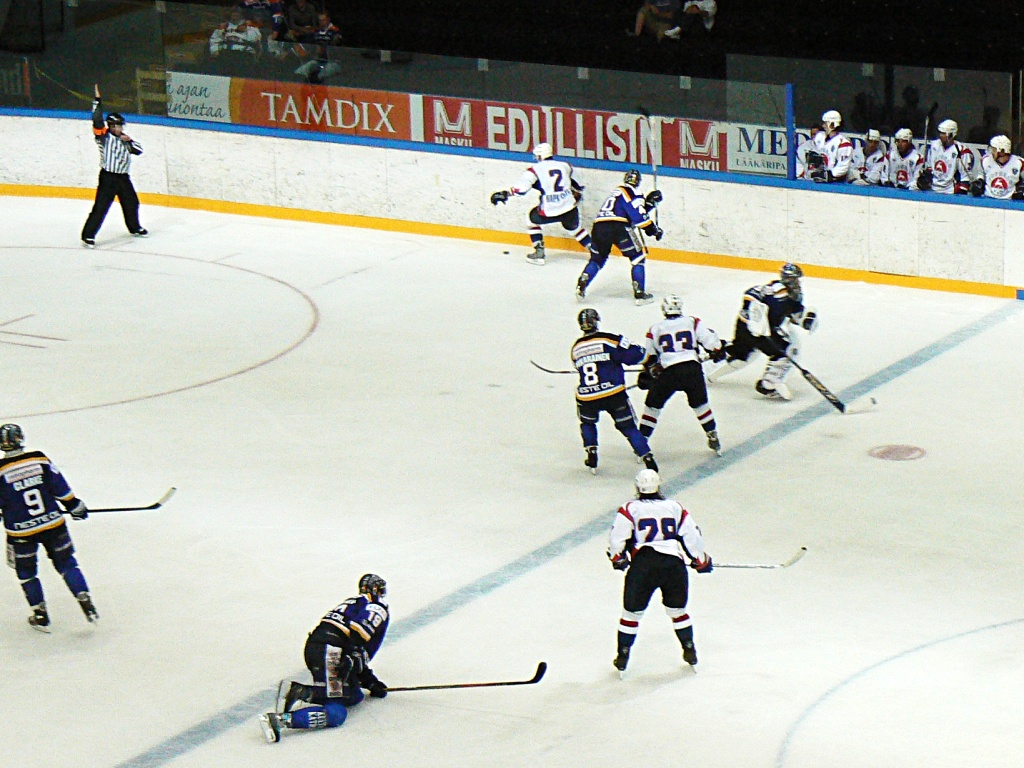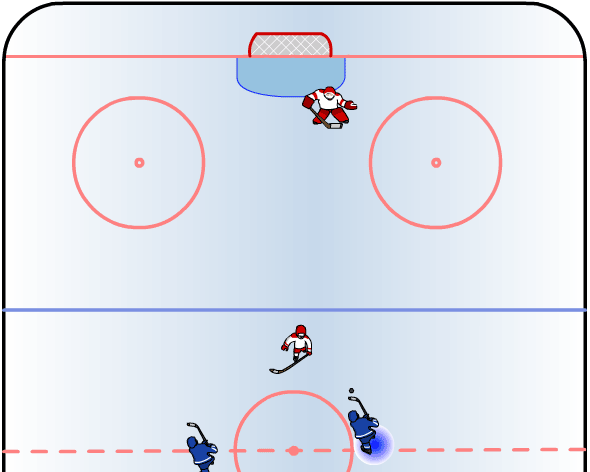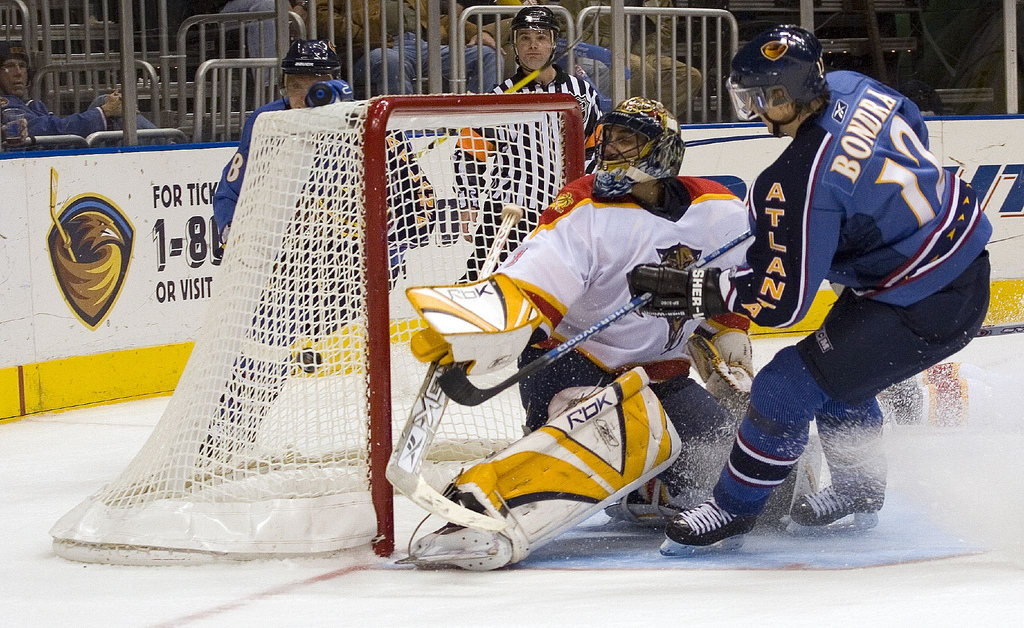|
Scott Campbell (ice Hockey, Born 1957)
Gary Scott Campbell (June 22, 1957 – September 3, 2022) was a Canadian ice hockey defenceman who was drafted first overall by the Houston Aeros of the World Hockey Association (WHA) in the 1977 WHA Amateur Draft. Campbell was born in Toronto, Ontario, but grew up in Guelph, Ontario. Playing career After a stellar junior career with the London Knights, Campbell was selected first overall by the Houston Aeros of the World Hockey Association (WHA) in the 1977 WHA Amateur Draft, as well as ninth overall by the St. Louis Blues of the National Hockey League (NHL) in the 1977 NHL amateur draft. Campbell opted to join the Aeros. Campbell played 149 WHA games for the Aeros and the Winnipeg Jets, and came to the NHL with the Jets when they joined that league in 1980. He and Morris Lukowich were the two players protected by the Jets from the dispersal draft, showing the faith the team had in his abilities. However, the cold weather in Winnipeg exacerbated a chronic asthma condition ... [...More Info...] [...Related Items...] OR: [Wikipedia] [Google] [Baidu] |
Defenceman
Defence or defense (in American English) in ice hockey is a player position that is primarily responsible for preventing the opposing team from Goal (ice hockey), scoring. They are often referred to as defencemen, D, D-men or blueliners (the latter a reference to the blue line in ice hockey which represents the boundary of the offensive zone; defencemen generally position themselves along the line to keep the puck in the zone). They were once called cover-point. In regular play, two defencemen complement three Forward (ice hockey), forwards and a goaltender on the ice. Exceptions include Overtime (ice hockey), overtime during the regular season and when a team is Short-handed, shorthanded (i.e. has been assessed a penalty), in which two defencemen are typically joined by only two forwards and a goaltender. In National Hockey League regular season play in overtime, effective with the 2015–16 NHL season, 2015-16 season, teams (usually) have only three position players and a goa ... [...More Info...] [...Related Items...] OR: [Wikipedia] [Google] [Baidu] |
Asthma
Asthma is a long-term inflammatory disease of the airways of the lungs. It is characterized by variable and recurring symptoms, reversible airflow obstruction, and easily triggered bronchospasms. Symptoms include episodes of wheezing, coughing, chest tightness, and shortness of breath. These may occur a few times a day or a few times per week. Depending on the person, asthma symptoms may become worse at night or with exercise. Asthma is thought to be caused by a combination of genetic and environmental factors. Environmental factors include exposure to air pollution and allergens. Other potential triggers include medications such as aspirin and beta blockers. Diagnosis is usually based on the pattern of symptoms, response to therapy over time, and spirometry lung function testing. Asthma is classified according to the frequency of symptoms, forced expiratory volume in one second (FEV1), and peak expiratory flow rate. It may also be classified as atopic or non-atopic, ... [...More Info...] [...Related Items...] OR: [Wikipedia] [Google] [Baidu] |
1975–76 OMJHL Season
The 1975–76 OMJHL season was the second season of the Ontario Major Junior Hockey League (OMJHL). The Windsor Spitfires were added as an expansion team, becoming the twelfth team in the league. The OMJHL splits into two divisions of six teams each. The southern and western teams joined the Emms division, named for Hap Emms. The northern and eastern teams joined the Leyden division, named for Matt Leyden. The OMJHL created three new trophies for the season. The Emms Trophy and the Leyden Trophy are awarded to the regular season champion of their respective divisions. The F. W. "Dinty" Moore Trophy (named for Francis Moore) is inaugurated for the first-year goaltender with the best goals-against-average. Twelve teams each played 66 games. The Hamilton Fincups won the J. Ross Robertson Cup, defeating the Sudbury Wolves. League business On May 9, 1975, officials from the OMJHL, Quebec Major Junior Hockey League and the Western Canada Hockey League, announced a constitution to establi ... [...More Info...] [...Related Items...] OR: [Wikipedia] [Google] [Baidu] |
Ontario Hockey League
The Ontario Hockey League (OHL; french: Ligue de hockey de l'Ontario (LHO)) is one of the three major junior ice hockey leagues which constitute the Canadian Hockey League. The league is for players aged 16–19. There are exceptions for overage players of 20 years of age. There are currently 20 teams in the OHL; seventeen in Ontario, two in Michigan, and one in Pennsylvania. The league was founded in 1980 when its predecessor, the Ontario Major Junior Hockey League, formally split away from the Ontario Hockey Association, joining the Canadian Hockey League, Canadian Major Junior Hockey League and its direct affiliation with Hockey Canada. The OHL traces its history of Junior A hockey back to 1933 with the partition of Junior A and B. In 1970, the OHA Junior A League was one of five Junior A leagues operating in Ontario. The OHA was promoted to Tier I Junior A for the 1970–71 season and took up the name Ontario Major Junior Hockey League. Since 1980 the league has grown rapid ... [...More Info...] [...Related Items...] OR: [Wikipedia] [Google] [Baidu] |
1974–75 OMJHL Season
The 1974–75 OMJHL season was the first season of the Ontario Major Junior Hockey League. The league operated semi-autonomously while still being part of the Ontario Hockey Association. The OMJHL inaugurated the William Hanley Trophy, awarded to the most sportsmanlike player. Eleven teams each played 70 games. The Toronto Marlboros won the J. Ross Robertson Cup, defeating the Hamilton Fincups. League business The Major Junior A Series of the Ontario Hockey Association (OHA) was rebranded as the Ontario Major Junior Hockey League (OMJHL) in 1974. The league began operating semi-autonomously from the OHA, and later became fully independent. Tubby Schmalz was appointed the first commissioner of the OMJHL on September 23, 1974. Schmalz set about to implement a revised mandatory player contract. It included a clause in which 20 per cent of a player's earnings during his first three professional seasons would go back to the junior clubs to recuperate development costs. He explained that ... [...More Info...] [...Related Items...] OR: [Wikipedia] [Google] [Baidu] |
Southern Ontario Junior A Hockey League
The Southern Ontario Junior A Hockey League was a Tier II Junior "A" ice hockey that lasted from the late 1960s until 1977 in Southern Ontario, Canada. The league was swallowed by what is now called the Ontario Provincial Junior A Hockey League in 1977. :The Big '10' ''Western Division'' Prior to 1956 :Western Ontario Junior "B" Hockey League 1956 - 1968 :Western Ontario Junior "A" Hockey League 1968 - 1970 :Southern Ontario Junior "A" Hockey League 1970 - 1977 History In 1956 the traditional Big '10' League was divided, its Western Division became the Western Ontario Junior "B" Hockey League, and the Central Division became the Central Junior "B" Hockey League. In the 1960s, the Western Junior "B" Hockey League was arguably the top league of Junior "B" hockey in Ontario. The Western's brass and the team owners felt that they should, as a whole, be promoted to Junior "A" status. In 1968 the league applied to the Ontario Hockey Association, but were declined by Jack Devine wh ... [...More Info...] [...Related Items...] OR: [Wikipedia] [Google] [Baidu] |
Guelph Biltmore Mad Hatters
The Guelph Biltmore Mad Hatters were a Canadian junior ice hockey team in the Ontario Hockey Association (OHA) from 1940 to 1942, and 1947 to 1960. The team was often known as the "Biltmores" and sponsored by the Guelph Biltmore Hat Company, and played home games at the Guelph Memorial Gardens. History The Guelph Biltmore Mad Hatters were a brief note in junior hockey history, but left an impression on the game during 13 years of operation. The team that was sponsored by a local manufacturer in the Royal City would capture a national championship, several provincial titles, and send four men on to the Hockey Hall of Fame. The team was founded as the Guelph Indians for the 1936-37 season. After four seasons, the Guelph Biltmore Hat Company became the team's sponsors. After two more seasons of play, the team was put on hiatus for World War II. The team was resurrected in 1947 as a farm team for the New York Rangers of the NHL and coached by former Rangers forward Alf Pike until th ... [...More Info...] [...Related Items...] OR: [Wikipedia] [Google] [Baidu] |
Penalty (ice Hockey)
A penalty in ice hockey is a punishment for an infringement of the rules. Most penalties are enforced by sending the offending player to a penalty box for a set number of minutes. During the penalty the player may not participate in play. Penalties are called and enforced by the referee, or in some cases, the linesman. The offending team may not replace the player on the ice (although there are some exceptions, such as fighting), leaving them short-handed as opposed to full strength. When the opposing team is said to be on a ''power play'', they will have one more player on the ice than the short-handed team. The short-handed team is said to be "on the penalty kill" until the penalty expires and the penalized player returns to play. While standards vary somewhat between leagues, most leagues recognize several common varieties of penalties, as well as common infractions. The statistic used to track penalties is called "penalty minutes" and abbreviated to "PIM" (spoken as single w ... [...More Info...] [...Related Items...] OR: [Wikipedia] [Google] [Baidu] |
Point (ice Hockey)
In ice hockey, point has three contemporary meanings. Personal stat A point is awarded to a player for each goal scored or assist earned. The total number of goals plus assists equals total points. The Art Ross Trophy is awarded to the National Hockey League (NHL) player who leads the league in scoring points at the end of the regular season. Team stat Points are also awarded to assess standings (or rankings). Historically, teams were awarded two points for each win, one point for each tie and no points for a loss. Such a ranking system, implemented primarily to ensure a tie counted as a "half-win" for each team in the standings, is generally regarded as British and/or European in origin and as such adopted by the National Hockey League which was founded in Canada where leagues generally used ranking systems of British origin. Awarding points in the standings contrasts with traditional American ranking systems favored in sports originating within the United States where today the m ... [...More Info...] [...Related Items...] OR: [Wikipedia] [Google] [Baidu] |
Assist (ice Hockey)
In ice hockey, an assist is attributed to up to two players of the scoring team who shot, passed or deflected the puck towards the scoring teammate, or touched it in any other way which enabled the goal, meaning that they were "assisting" in the goal. There can be a maximum of two assists per goal. The assists will be awarded in the order of play, with the last player to pass the puck to the goal scorer getting the primary assist and the player who passed it to the primary assister getting the secondary assist. Players who gain an assist will get one point added to their player statistics. Despite the use of the terms "primary assist" and "secondary assist", neither is worth more than the other, and neither is worth more or less than a goal. Assists and goals are added together on a player's scoresheet to display that player's total points. Special cases If a player scores off a rebound given up by a goaltender, assists are still awarded, as long as there is no re-possession by t ... [...More Info...] [...Related Items...] OR: [Wikipedia] [Google] [Baidu] |
Goal (ice Hockey)
In ice hockey, a goal is scored when the puck entirely crosses the goal line between the two goal posts and below the goal crossbar. A goal awards one point to the team attacking the goal scored upon, regardless of which team the player who actually deflected the puck into the goal belongs to (see also own goal). Typically, a player on the team attempting to score shoots the puck with their stick towards the goal net opening, and a player on the opposing team called a goaltender tries to block the shot to prevent a goal from being scored against their team. The term goal may also refer to the structure in which goals are scored. The ice hockey goal is rectangular in shape; the front frame of the goal is made of steel tube painted red (blue in the ECHL because of a sponsorship deal with GEICO) and consists of two vertical goalposts and a horizontal crossbar. A net is attached to the back of the frame to catch pucks that enter the goal and also to prevent pucks from entering it ... [...More Info...] [...Related Items...] OR: [Wikipedia] [Google] [Baidu] |
Season (sports)
In an organized sports league, a typical season is the portion of one year in which regulated games of the sport are in session: for example, in Major League Baseball the season lasts approximately from the last week of March to the last week of September. In other team sports, like association football or basketball, it is generally from August or September to May although in some countries - such as Northern Europe or East Asia - the season starts in the spring and finishes in autumn, mainly due to weather conditions encountered during the winter. A year can often be broken up into several distinct sections (sometimes themselves called seasons). These are: a preseason, a series of exhibition games played for training purposes; a regular season, the main period of the league's competition; the postseason, a playoff tournament played against the league's top teams to determine the league's champion; and the offseason, the time when there is no official competition. Preseason In ... [...More Info...] [...Related Items...] OR: [Wikipedia] [Google] [Baidu] |




